So there I was at Refugio Paz de Las Aves, teetering on the edge of sanity after a barrage of insane Ecuadorean avifauna. First came the famed feeder birds, a parade of preposterous birds including but certainly not limited to guans, toucanets, barbets, pihas, and mountain-tanagers. Next were the star attractions, the amazing antpittas of Paz de Las Aves. My head was fairly swimming as my mind tried to process the morning’s unfathomable sightings. The good news was that a bench was near by. The bad news, at least for my reeling senses, was that the bench was parked right in front of a world-class array of hummingbird feeders. Here we go again…
Just one day prior to this visit, I experienced the profound pleasure of watching hummingbirds at Yanacocha Reserve. Paz de Las Aves is situated at a lower altitude than Yanacocha, which meant that the hummingbirds there were entirely different but no less amazing.
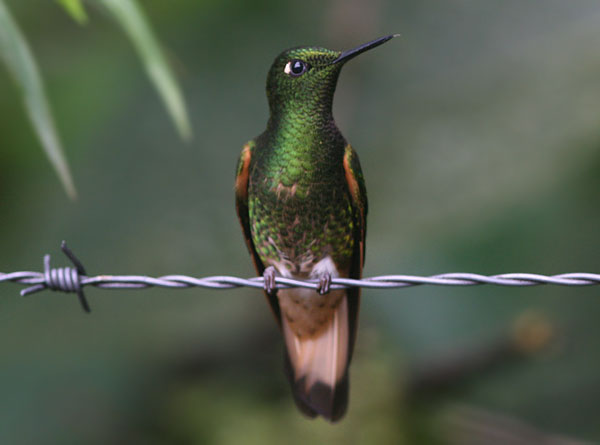
Buff-tailed Coronets were common, confiding, and very cool
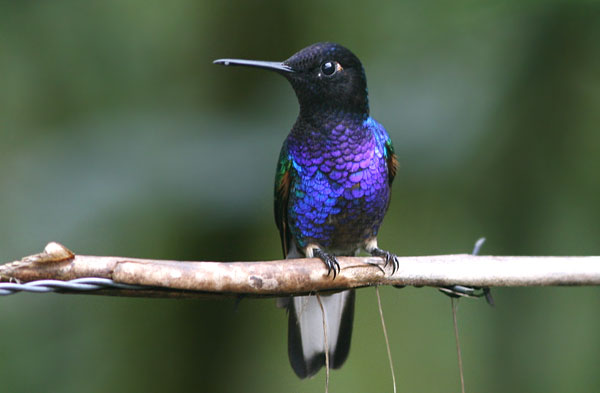
However, their resplendent kin, Velvet-purple Coronet really stole the show
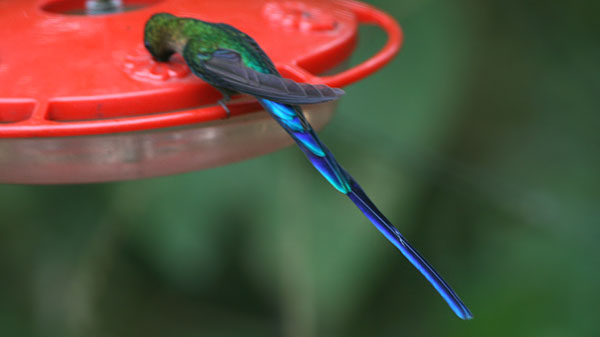
Another big deal bird was the aptly-named Violet-tailed Sylph
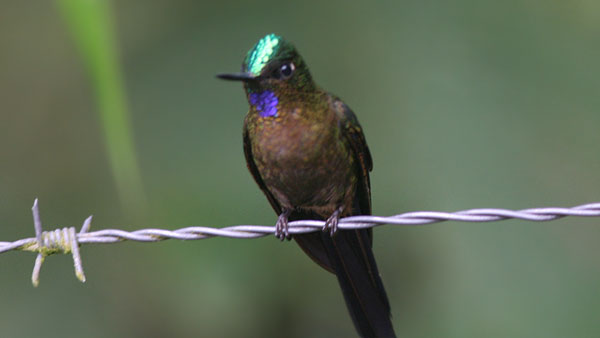
This shot of a sylph immature male shows that the bird is gorgeous from top to tail
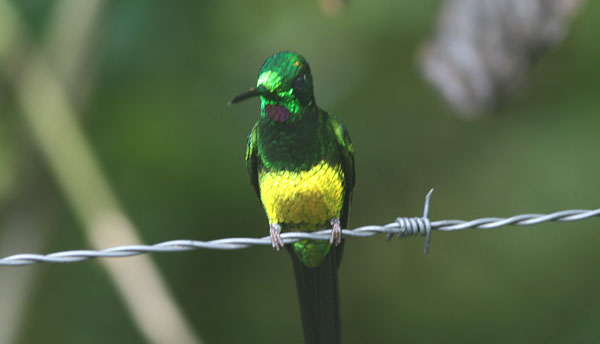
Speaking of sharp, the Empress Brilliant really is brilliant when the light hits it right
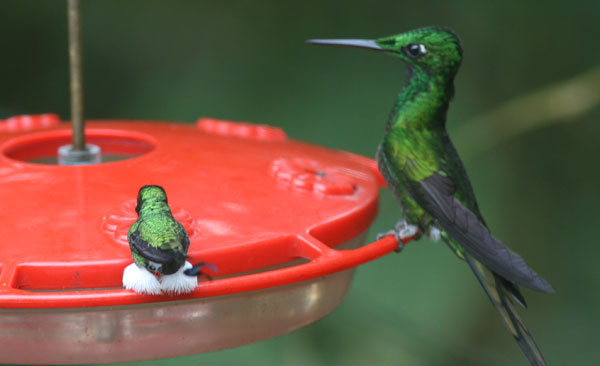
The Empress Brilliant dwarfs the beauteous Booted Racket-tail. The boots are evident here while the tail needs to wait for another day.
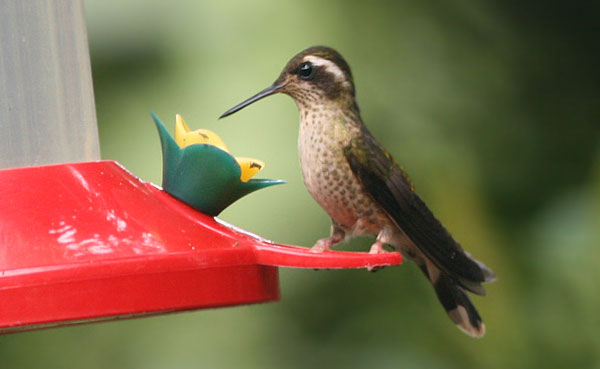
Not all the local hummers are exactly gaudy. Take this Speckled Hummingbird for instance.
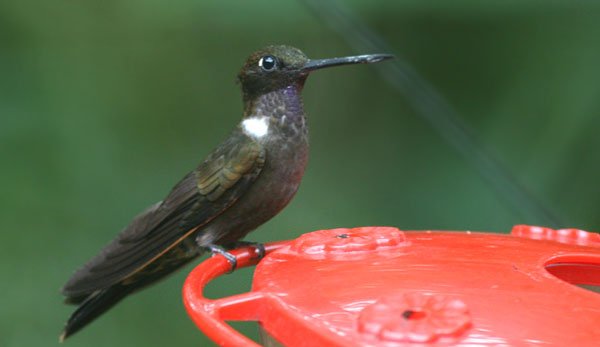
Another subdued yet sexy species is the Brown Inca, with a gorget that flashes violet in the right light
These species were joined at the feeders by Andean Emeralds and Fawn-breasted Brilliants, which I’ll feature in a future post, as well as Rufous-tailed Hummingbirds, which I never got good shots of. Nonetheless, by the time I pulled myself away for empanadas and coffee, my camera was practically smoking!
The legend of Refugio Paz de Las Aves and its amazing antpittas is far more than a birding curiosity. Rather, its success represents a true triumph of ecotourism. Had the Paz brothers not learned to spin disemboweled worms into birding gold, they would, by their own account, have cleared the cloud forest for subsistence agriculture. Instead, their ingenuity and entrepreneurship have resulted in their business success along with life antpittas for bird watchers the world over. I feel privileged to have visited this site and strongly suggest that anyone with an interest in the wonder of the natural world would feel the same.













Smashing hummingbirds, Mike. Good job!. It is funny that 15 years ago in the Mindo area, both Velvet-breasted Coronet and Empress Brilliant were quite difficult. I considered myself lucky to have seen the former at the entrance road to Mindo. The Brilliant lured me on several trips to the area. No problems now of course when they come to feeders. And there are feeders everywhere today in that region. Back then, there was not a single one as I can recall. It is a remarkable change that the Mindo area has gone through in relatively short time. In 1995 more and more pastures were opened and forest cut down and burnt. Cattle was the main economy. Today, many of the former pastures have re-turned to become secondary forest and are protected in private reserves or eco-tourism operations.
GREAT post, Mike! It’s funny that you and I did posts about our Ecuador experiences at just about the same time. The rest of the BSBO gang is at the Tandayapa Bird Lodge right now and I believe they’re scheduled to visit ‘The Antpitta Whisperer’ tomorrow morning.
I was feeling a bit ‘glum’ about the fact that they’re watching swarms of hummingbirds on the patio at Tandayapa while I’m watching from my kitchen window as a mess of cowbirds eat all my bird seed. So…I decided to do a little retrospective post about our Ecuador trip in 2006.
Kenn wrote a really wonderful story about our time with Angel for BWD and I posted it on the blog yesterday. I don’t usually promote our blog very well, but since you’ve been there, you should read Kenn’s story. He really captured the essence if the experience.
~kim
Gunnar, thanks for the perspective. I can only imagine how hard it was to find these hummers before every lodge and refuge set up feeders. Of the 30+ hummingbird species I saw on either slope of the Andes, only a fraction turned up away from feeders.
Kim, thanks for the compliment. I’m surprised you’re so gracious about your BSBO buddies heading down to Ecuador since you were so cruel to me!! I love both your retrospective and Kenn’s original Antpitta Whisperer article. You mention some spots I’ll be reviewing soon like Papallacta Pass and Guango Lodge as well as places I can’t wait to visit in the future. Sacha in the Amazon sounds unforgettable.
I’m working hard to swallow my jealousy. Great stuff.
Just astonishing birds…
Great shots! I never knew the Booted Racket-tail was so small. What kind of feeder are you using? I definitely want one if it will get me pictures anywhere close to these.
Thanks, Mike, for showing us two brownish hummers. Not quite the sparrows I had begged for, but nevertheless a merciful act to those of your readers who are bound to their work desks and wintery northern hemisphere homes. 😉
Of course jealousy springs to mind immediately, but I am also genuinely happy that you had such an amazing trip!
Thanks, all!
Jochen, some drab hummingbirds are as much as you can expect from me as far as mercy goes. I plan to continue to fan the flames of your jealousy, both to keep you warm until spring arrives and encourage you to visit Ecuador yourself (perhaps w/ one of the 10,000 Birds team…)
That is very kind of you – keeping me warm until spring arrives – but you are aware of the kind of migrant warblers that I am “looking forward” to? A bit of cool-bloodedness seems more appropriate…
🙂
And 10,000 Birds is doing a seriously good job of bringing great birding destinations to your readers’ attention. Yupp, I guess those antpittas are on my life’s agenda now.
Wow great shots, such beautiful birds. Been reading lots of great reviews about different feeders and noticed the ones that get the best reviews like perky pet are all red just like the one you have in the picture here. Is it true hummingbirds are attracted to the color red?
@Betsy: Hummingbirds are attracted to the color red but one should NOT use dyed-red “hummingbird nectar” as the dye is actually not good and unnecessary.
If you are really lucky and wear a red hat, or a shirt with red on it, sometimes a hummingbird will come in for a close look – an experience you won’t soon forget!